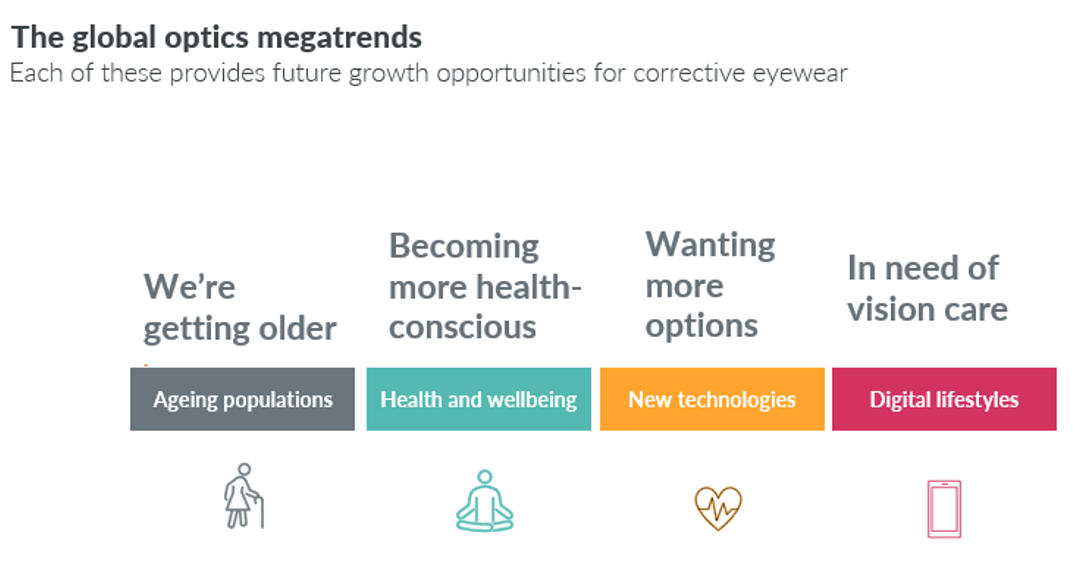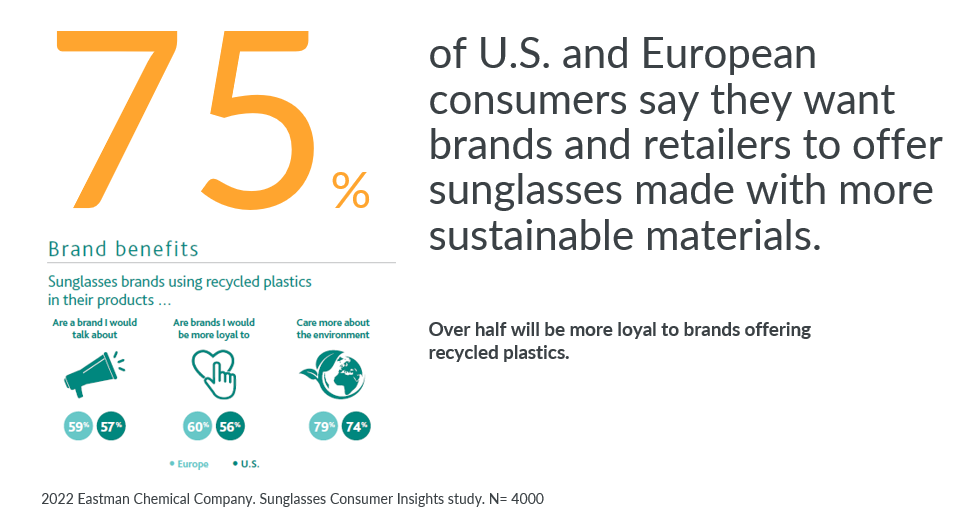Eye health and vision correction are incredibly important in today’s fast-paced, digitized world. People across the world spend more time in front of screens than ever before, and the result is an increased incidence of the refractive condition myopia, also known as short-sightedness.
Big demographic shifts are happening too. Populations around the world are aging at such a rate that the number of over 60-year-olds in 2050 will be double the number in 20151. As people get older, they are more likely to need reading glasses or specialty contact lenses for presbyopia, commonly known as age-related long-sightedness.
Both of these shifts in lifestyle and demographics are megatrends that are fueling demand today, and will continue to shape the future market for corrective eyewear, glasses and contact lenses. These products must not only provide vision correction, but satisfy consumer demand for flexibility, comfort and fashion.
Drawing on GfK’s Optics point-of-sale panel data from markets around the world, we can see the impact these eyewear trends are having on sales right now. But combining retail sales data with consumer information and market expertise allows us to get a clearer vision of what lies ahead for consumers, brands and retailers in the Optics sector.

Contact lens trends 2023
The global contact lens market grew by 6% in the first half of 2023 vs H1 2022, in USD fixed currency value terms, with all regions contributing to value growth.
Global sales volume, however, is only slightly positive, being held afloat by strong sales performance in Asian markets. Beauty lenses are especially popular in Asian markets, with colored lenses making a comeback from their pandemic-driven downturn. The China market is recovering from a double-digit decline in sales volume in 2022, driven by strict anti-COVID-19 measures, the market now growing 1% in volume in H1 2023 vs the prior year. Social media platforms are a hugely successful route to market in China, giving products the limelight next to influencers and celebrities. Social commerce now takes almost a 30% share of the online market for contact lenses.
“A major characteristic of social commerce is the competitiveness of local brands against multinational brands, due to their more affordable prices, and their product promotions are more localized too.” – Joel Zhong, Account Manager – Optics, China.
In contrast, the US market is down 1% in volume but growing 6% in value, driven in part by mix effects – such as trading up in material and to daily contact lenses, but predominantly due to price rises across leading branded contact lenses in the market.
Despite being more than double the price of reusable contact lenses (on a like-for-like daily use basis), soft daily contact lenses have grown in popularity worldwide and now have almost 60% value share of all replacement modalities, vs just over half the market in 2019.
The pandemic marked a permanent shift in contact lens wearing habits. According to GfK’s 2023 Consumer Life study, almost 50% of employees worldwide report working either exclusively or partly from home. Staying home behind closed doors can make wearing glasses a cost-effective option, while a hybrid work lifestyle makes daily contact lenses attractive. Daily contact lenses offer the convenience and flexibility of wearing them on an as-needs basis, from office days and travel to social events. Unlike reusable lenses, there’s no need for storage or solution, lowering the risk of contamination. Leading products on the market also promote the latest in lens technology for comfort, involving keeping the eyes moist throughout the day.
Along with daily lens growth, the other major growth segments are toric and multifocal. Toric lenses are prescribed predominantly for the common refractive condition astigmatism, while multifocal lenses are prescribed for age-related long-sightedness. More than eight out of 10 people aged 45 or older are long-sighted, according to U.S. research2, and with aging populations, the worldwide demand for multifocal lenses is sure to increase. Along with aging, prevention and treatment of short-sightedness from a young age is now a focus area, with the average time spent in front of digital devices longer than it was prior to the pandemic. The negative effect of screen time on eyesight has been confirmed in many countries’ studies3. It also means that providing citizens of all ages access to quality and affordable eye care is essential for developed and emerging countries alike.
Contact lens wearers are demanding not only comfort and convenience but also more sophisticated/advanced technologies. Contact lenses that slow down the progression of myopia in children are already on the market. The future may bring smart contact lenses, which can monitor blood glucose levels4, allowing contact lenses to join the ranks with other wearable devices measuring health aspects in real time.
Glasses and sunglasses trends 2023
GfK’s panels for spectacle frames and lenses show that sales are still in recovery from the pandemic downturn, as the global crisis disrupted normal purchase cycles. Most consumers have now made their purchases following the lifting of pandemic lockdowns.
Lenses: Volume of lens sales is driven by price growth, in part due to the raw material price increases, but mostly due to the rising demand of more expensive lens types. Progressive lenses, those designed to provide clear vision at multiple distances with a gradual change of power across the lens surface, are growing 5% in volume and value. Growing at similar rates are proximity lenses, also known as “indoor lenses”, which offer advantages to people with long-sightedness who also spend many hours in front of a screen. These growth segments offer premium functionality and are being fueled again by the underlying trends of an aging population and one that is also working longer and spending more time in front of digital devices.
Frames: Volume declined 2% in H12023 vs H12022, but value grew 1%, driven by premiumization as iconic and fashion eyewear brands once again take center stage. In Europe, frames priced from €150 are driving growth, with four of the top five brands in this price segment in growth.
Sunglasses: Both a fashion item and offering UV protection as well as optional vision correction, sunglasses are linked to aesthetics and lifestyle. Boosted by the ongoing recovery of tourism, the global sunglasses traditional retail market grew by 2% in both value and volume in H1 2023. However, volume and value sales have not recovered to pre-pandemic levels. As sunglasses are a must-have item in the car or handbag, the question is whether consumers need to own several pairs like they might have in the past. Instead, premiumization is the key trend, with the most premium >€250 price band growing 19% in value. Sunglasses are also a category where luxury brands can become accessible – a luxury brand’s handbag may cost thousands of euros, but the same brand’s sunglasses cost around €200. Despite economic headwinds, the luxury market is thriving as the ultra-rich continue to spend. Indeed, the top 2% of spenders in 2022 accounted for 40% of sales, compared with 35% in 20095.
The spotlight is also on sustainable frames, from the use of bio-acetate to completely recycled plastic frames, with most major brands carving out dedicated sections of their websites for eco-friendly glasses. As with sunglasses, less will become more, as eco-awareness grows as well as accessible luxury.
“Looking ahead, luxury sunglass brands are expected to keep growing their appeal. Many brands have seen considerable success through rebranding and revamping established luxury names, making these brands increasingly popular with younger generations. Savvy use of influencers and social media marketing has also contributed to this demand.” – Davide Defabiani, Senior Consultant – Market Insights, Italy.
Conclusion
The market for eyewear is evolving – fueled by health and wellbeing, demographic shifts, lifestyle trends, and aesthetics. Advances in technology will meet healthcare to create advantages we can today only dream of. Consumer needs and preferences in the future need to be coupled with vision correction, bringing to life products that are integrated into a consumer’s lifestyle. For brands and retailers, this means that sales and consumer data are required more than ever before.
Bring your market into focus with data and insights from the GfK Optics Panel
3 Ivarez-Peregrina C, Sánchez-Tena M, Martinez-Perez C, et al. The relationship between screen and outdoor time with rates of Myopia in Spanish Children. Front Public Health. 2020;8: 560378.
Landreneau JR, Hesemann NP, Cardonell MA. Review on the myopia pandemic: epidemiology, risk factors, and prevention. Mo Med. 2021;118(2):156–63.
Hu J, Ding ZY, Han D, et al. Analysis of influencing factors of myopia among primary and middle school students in Suzhou. China J Pre Med. 2021;33(03):241–5.
4 https://www.science.org/doi/10.1126/sciadv.aap9841
5 Bain & Company, 2022





